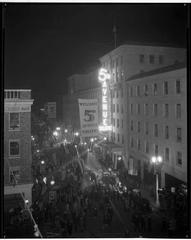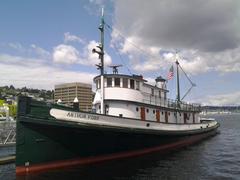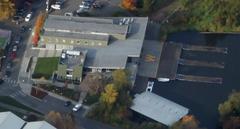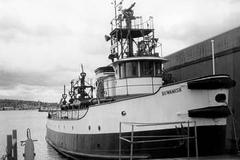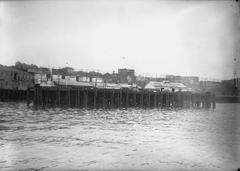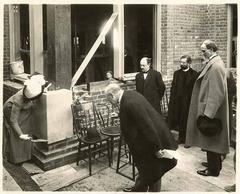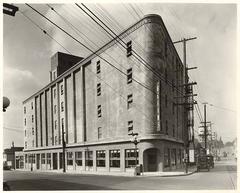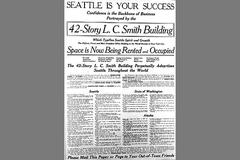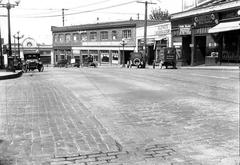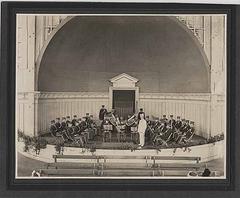Gas Works Park Seattle: Visiting Hours, Tickets, and Visitor Guide
Date: 03/07/2025
Introduction
Nestled along the north shore of Seattle’s Lake Union, Gas Works Park is a living monument to the city’s industrial past and a pioneering example of urban renewal. Once the site of the Seattle Gas Light Company’s coal gasification plant, it now serves as a vibrant public space renowned for its stunning views, preserved industrial structures, and community events. This detailed guide covers everything you need to plan your visit, from hours and accessibility to the park’s fascinating history and cultural significance.
Table of Contents
- Introduction
- Historical Overview and Transformation
- Visitor Information
- Key Features and Visitor Experience
- Major Annual Events
- Frequently Asked Questions (FAQ)
- Summary and Recommendations
- References
Historical Overview and Transformation
Early Industrial History: The Seattle Gas Light Company Era (1906–1956)
Gas Works Park occupies the former grounds of the Seattle Gas Light Company’s manufactured gas plant, which operated from 1906 until 1956. The facility provided coal gas for heating, lighting, and cooking, playing a vital role in Seattle’s early growth. However, the plant was also notorious for its environmental impact, with air, soil, and water pollution earning it the reputation of an “unwelcome neighbor.” Residents even oriented their homes to avoid views of its smoke-belching towers (Seattle Times; Klook).
The arrival of natural gas in 1956 made the plant obsolete, leaving behind nearly 20 acres of heavily contaminated land (The Urbanist).
From Industrial Wasteland to Urban Vision
After the plant’s closure, the land’s prime location attracted various redevelopment proposals. Initial ideas called for demolition of the industrial remains, but University of Washington landscape architect Richard Haag proposed a radical alternative: preserve and repurpose the industrial structures as sculptural and recreational elements within a new urban park (Washington.edu). This vision, initially controversial, was adopted by the City of Seattle in 1970 and laid the groundwork for a new era in landscape architecture.
Environmental Remediation and Landscape Innovation
Turning a contaminated site into a safe public space required innovative remediation. Haag and his team pioneered bioremediation—using plants to absorb and break down toxins in the soil (The Urbanist). The most polluted earth was capped with clay and sculpted into the park’s now-iconic Great Mound (Kite Hill), which offers sweeping views of the city and mountains. Key industrial relics—like the cracking towers and boiler house—were cleaned and repurposed as picnic shelters and play spaces (Washington.edu; Klook).
Opening and Cultural Impact
Gas Works Park opened in stages beginning in 1973 and was officially dedicated in 1975 (Seattle Times). Its bold design and preserved industrial features challenged notions of urban beauty and offered a new model for reclaiming damaged landscapes. The park quickly became a cherished gathering place, hosting everything from music festivals to Independence Day fireworks (CityDays).
Recognition and Ongoing Legacy
Gas Works Park is the only preserved coal gasification plant in the U.S. transformed into a public park (Klook). It earned awards from the American Society of Landscape Architects and was listed on the National Register of Historic Places in 2013 (Washington.edu; The Urbanist). Its success has influenced urban planning and inspired similar projects worldwide (CityDays).
Visitor Information
Visiting Hours and Entry
- Open daily: 6:00 AM to 10:00 PM (Seattle Parks and Recreation)
- Admission: Free
- Event tickets: Required for some large events (e.g., music festivals, July 4th celebrations). See event pages for details.
Accessibility
- Paths: Main routes are paved, but some areas—including Kite Hill—can be steep or grassy. Most key facilities are wheelchair accessible.
- Parking: Limited free parking with a four-hour limit; fills quickly during major events. Additional street parking in Wallingford or paid lots nearby.
- Public Transit: Served by King County Metro routes 26 and 28.
- Biking: Connected to the Burke-Gilman Trail, with bike racks at entrances.
Guided Tours and Events
While regular guided tours are not scheduled, special events and occasional historical or environmental tours are offered. Check the Seattle Parks website or local event listings for the latest updates.
Activities and Photo Spots
- Kite Flying: The Great Mound is Seattle’s best-known kite spot.
- Picnicking: Lawns and picnic shelters are ideal for gatherings.
- Photography: Industrial relics and skyline views are a photographer’s dream.
- Walking/Biking: Trails connect key park features and the Burke-Gilman Trail.
Nearby Attractions
- Lake Union: Kayaking and paddleboarding available nearby.
- Fremont: Quirky shops, cafes, and the Fremont Troll sculpture.
- Museum of History & Industry: A short distance south at Lake Union Park.
Key Features and Visitor Experience
The Old Gasification Plant
Preserved towers, pipes, and machinery remain as dramatic reminders of the site’s industrial history, making the park a unique destination for exploration and photography (Klook).
The Great Mound (Kite Hill)
This 45-foot-high mound, created from remediated soil, is a favorite for kite flying, picnics, and panoramic urban views. At the summit, a sundial artwork uses visitors’ shadows to tell the time (CityDays).
Recreational Lawns
Expansive grassy areas are perfect for lounging, frisbee, and group activities. The Burke-Gilman Trail provides easy access for walkers and cyclists.
Play Barn
Located in the former exhauster-compressor building, the Play Barn is a children’s play area that incorporates repurposed industrial elements (Washington.edu).
Major Annual Events
- Seafair Summer Fourth: Seattle’s largest Independence Day party, with live music, food trucks, and fireworks over Lake Union. Admission is free; VIP seating requires tickets.
- Summer Series: Free Friday evening events throughout summer (music, arts, and community performances).
- Anjunadeep Open Air Seattle: August 24, 2025. Electronic music festival (tickets required).
- Diplo’s Run Club: September 14, 2025. 5K run and after-party with DJ Diplo (registration required).
Event schedules may change; check official sources for updates.
Frequently Asked Questions (FAQ)
Q: What are the park’s opening hours?
A: 6:00 AM to 10:00 PM daily.
Q: Is there an entrance fee?
A: No, general admission is free.
Q: Is the park accessible for people with disabilities?
A: Main paths are accessible, though some terrain can be challenging. Alternative accessible parks nearby include Lake Union Park.
Q: Are pets allowed?
A: Yes, dogs are welcome on leashes; owners must clean up after them.
Q: Can I swim or fish in Lake Union at Gas Works Park?
A: No. Swimming, fishing, and wading are prohibited due to hazardous sediments.
Q: Are guided tours available?
A: Occasionally, for special events. Check the Seattle Parks and Recreation website for updates.
Summary and Recommendations
Gas Works Park stands as a testament to Seattle’s innovative spirit, environmental resilience, and celebration of community life. Its transformation from a polluted gasification plant into a vibrant urban park is a model for sustainable design and adaptive reuse. With free admission, extended hours, and amenities for all ages, it is an essential stop for anyone exploring Seattle. For the latest visitor information, event updates, and travel tips, consult Seattle Parks and Recreation and related resources.
Visitor Tips:
- Arrive early for popular events to secure parking and a good spot.
- Dress in layers for Seattle’s changing weather.
- Respect park rules—keep dogs leashed, pack out your trash, and avoid climbing on industrial equipment.
- Use public transit or bike when possible, especially during major celebrations.
References
- Seattle Times: How Gas Works: From Belching Hellscape to Post-Industrial Paradise
- The Urbanist: Fridaygram—Gas Works Park
- Washington.edu: Redefining the Urban Park
- The Cultural Landscape Foundation: Gas Works Park Recognized for Its Significance
- Klook: Gas Works Park Seattle
- Seattle Parks and Recreation: Gas Works Park
- CityDays: Gas Works Park
- Amusing Planet: Gas Works Park in Seattle
